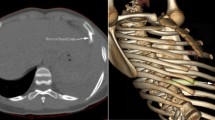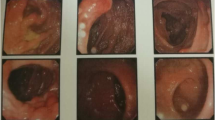Abstract
A 17-month-old boy presented with a palpable anterior chest wall mass and was evaluated by chest radiography, sonography, and MRI. No history of trauma was provided initially. Sonography and MRI showed a costal cartilage fracture with overlying hematoma. Identification of a fracture isolated to the costal cartilage is rare and this is a unique case among children. In the appropriate clinical setting, costal cartilage fractures can be confirmed by sonography alone, and follow-up assessment can be based on clinical evaluation without the need for additional cross-sectional imaging.
Similar content being viewed by others
Avoid common mistakes on your manuscript.
Introduction
Costal cartilage fractures are not seen on chest radiographs unless heavily calcified, a process that begins in adulthood [1]. Cartilaginous injuries, however, can be assessed with cross-sectional imaging including sonography, CT, and MRI. Although sonography has been used in several studies in adults for the evaluation of rib pathology, a review of the literature identified only two case studies that specifically address the use of sonography for the diagnosis of traumatic rib injuries in children [2–4]. These include a recent case report by Kelloff et al. [5], which describes the use of sonography for the diagnosis of an acute osseous rib fracture in a 9-week-old boy. A second case report by Smeets et al. [6] describes the sonographic detection of a costochondral dislocation. In both cases, the rib injuries were not identified on chest radiography. This report presents the unique case of a 17-month-old boy who presented with a palpable mass in the mid-anterior chest caused by a fracture isolated to the costal cartilage and seen on both sonography and MRI.
Case report
An otherwise healthy 17-month-old boy presented to his primary care physician after his parents noticed a tender, palpable mass along the medial aspect of his right anterior chest. No specific trauma history was provided. Bleeding, bruising, or signs of infection were not seen on physical examination. Initial frontal and lateral chest radiographs were normal. Focused sonography showed a relatively well-defined 2-cm solid mass in the subcutaneous tissues corresponding to the palpable abnormality (Fig. 1), with minimal internal Doppler color flow. The child was referred for MRI, which showed a focal, heterogeneous T2-signal intensity mass with peripheral contrast enhancement adjacent to a non-displaced vertical cartilage fracture of a mid-thoracic rib (Fig. 2).
Axial fat-suppressed fast spin-echo inversion recovery (TR/TE/TI 3,000/38/155 ms) MR image at the level of the palpable chest wall mass shows a linear region of high signal intensity within the costal cartilage of a mid-right anterior rib (arrow), consistent with a nondisplaced vertical cartilage fracture
On retrospective review of the sonographic clip sequence, a fracture isolated to the costal cartilage was identified (Fig. 3). Clinical and sonographic follow-up showed a decrease in mass size, consistent with a resolving hematoma. Calcification was noted adjacent to the healing cartilaginous fracture on follow-up sonography (Fig. 4). A possible fall onto a coffee table was eventually recalled by the child’s grandfather. Thorough clinical evaluation raised no suspicion of child abuse.
Transverse sonographic image at the level of the palpable mass (presumed to be a hematoma), shows a linear region of hyperechogenicity within the hypoechoic costal cartilage (arrow), consistent with a nondisplaced vertical costal cartilage fracture. This corresponds to the abnormality identified on MRI
Discussion
Isolated costal cartilage fractures are uncommonly reported because of infrequent occurrence and underdiagnosis [3, 4]. Fractures usually occur within the osseous portion of the rib and occasionally at the costochondral junction. Posterior rib fractures, when located at or near the costovertebral junction, have been reported as highly specific for child abuse [7]. Anterior rib fractures, particularly those involving the costochondral junction and costal cartilage, present a greater diagnostic challenge. Radiographically occult anterior rib injuries might present as a new chest wall mass in the young child or as focal pain, with or without an associated mass, in the older child. Differential considerations for a new chest wall mass include neoplasm, infectious or inflammatory processes, and posttraumatic hematoma [8].
In young children, sonography usually is the preferred modality for initial evaluation of a chest wall mass. Attention must be paid to the underlying ribs, even in the absence of reported trauma, with care taken to avoid several potential pitfalls of rib sonography. These difficulties include confusion of the pleural surface with rib cortex, pseudofractures caused by transducer position overlying a rib and either the intercostal space or scapula, and costal cartilage calcifications running parallel to the rib surface (which are unlikely in the pediatric population) [3]. For costal cartilage injuries, fracture identification is important, as healing cartilage can show an atypical histological appearance and thereby mimic a malignant tumor [4]. Fractures can be identified by visualization of a fracture line, step-off deformity, or gas within the cartilage cleft at a costochondral junction.
When a mass is not present to guide localization, sonographic evaluation of traumatic rib injuries in children, both osseous and cartilaginous, is complicated by the time-intensive nature of the examination. Although older children and adults can often guide the examination by identifying the site of trauma or pain, small children might be unable to provide such information. Furthermore, performing sonography in an uncooperative, dyspneic, or severely injured child can be very challenging [3]. In this case, as in the reports by Kelloff et al. [5] and Smeets et al. [6], where patients presented with a palpable hematoma and palpable crepitus, respectively, physical examination guided the sonographic evaluation.
Despite its limitations, sonography has been shown to increase the sensitivity for detection of cartilaginous and osseous rib fractures in adults. Malghem et al. [4] presented a series of eight adults with costal cartilage fractures diagnosed by sonography and CT. None of the fractures was seen on chest radiography [4]. Griffith et al. [3], in a study of 50 adults who presented with the clinical suspicion of a rib fracture, demonstrated the poor ability of chest radiography to identify either osseous or cartilaginous rib fractures. Radiography showed a sensitivity of only 15%, compared to 90% for sonography. Although costal fractures are rarely reported in the literature, five isolated costal cartilage fractures were found in the latter study, accounting for 6% of the total fractures identified. In addition, all patients with a hematoma had an underlying rib fracture. These studies suggest that costal cartilage fractures are underdiagnosed and that in the setting of high clinical suspicion and normal chest radiography, especially when associated with a new mass, focused sonography might provide a definitive diagnosis.
In conclusion, we suggest that if entertained as a diagnostic consideration in a child with an appropriate clinical history, a costal cartilage fracture can be confirmed with sonography alone. No additional cross-sectional imaging studies are necessary, and follow-up can be based on clinical assessment alone.
References
Ontell FK, Moore EH, Shepard JA et al (1997) The costal cartilages in health and disease. Radiographics 17:571–577
Choi YW, Im JG, Song CS et al (1995) Sonography of the costal cartilage: normal anatomy and preliminary clinical application. J Clin Ultrasound 23:243–250
Griffith JF, Rainer TH, Ching AS et al (1999) Sonography compared with radiography in revealing acute rib fracture. AJR 173:1603–1609
Malghem J, Vande Berg B, Lecouvet F et al (2001) Costal cartilage fractures as revealed on CT and sonography. AJR 176:429–432
Kelloff J, Hulett R, Spivey M (2009) Acute rib fracture diagnosis in an infant by US: a matter of child protection. Pediatr Radiol 39:70–72
Smeets AJ, Robben SG, Meradji M (1990) Sonographically detected costo-chondral dislocation in an abused child. A new sonographic sign to the radiological spectrum of child abuse. Pediatr Radiol 20:566–567
Carty H (1997) Non-accidental injury: a review of the radiology. Eur Radiol 7:1365–1376
Donnelly LF, Frush DP (1999) Abnormalities of the chest wall in pediatric patients. AJR 173:1595–1601
Author information
Authors and Affiliations
Corresponding author
Rights and permissions
About this article
Cite this article
Orth, R.C., Laor, T. Isolated costal cartilage fracture: an unusual cause of an anterior chest mass in a toddler. Pediatr Radiol 39, 985–987 (2009). https://doi.org/10.1007/s00247-009-1276-8
Received:
Revised:
Accepted:
Published:
Issue Date:
DOI: https://doi.org/10.1007/s00247-009-1276-8








